Extreme Kayak Fishing
By Jerry White
Let's first define "extreme" as it pertains to kayak fishing. To me, it translates to targeting fish that are potentially dangerous due to size, attitude, or armament. It can mean targeting any fish in areas that normally only motorized boats could or would venture. It can also mean angling using a kayak in a manner that would make your loved ones verify your life insurance policy premiums are up to date, or have you fitted for one of those fashionable white coats that tie in the back. Comparing this form of paddle angling to conventional fishing is like comparing quail hunting to Grizzly bear hunting. To my knowledge, no one ever got mauled by a ticked off quail.
Let's take a look at this emerging segment of the sport - first from a distance, and then close up.
Practice From A Boat:
Just as you learn to ride a bike with some help from training wheels, target and catch your extreme fish from a boat before you ever try it from a paddle craft. And if at all possible, use a guide. Guides target particular species every day, and they will be a great resource to help you understand how these fish behave when they're hooked and also where they can be found.
Preparation:
Most people that push the limits of kayak fishing do so because they've "been there and done that" with conventional methods. Every time we release a fish, we hope that the next cast will bring us an even larger fish. Catching large fish, sometimes in less than perfect conditions, can challenge your balance and endurance. So make sure you're fully prepared physically and mentally before you launch. When getting prepared for this sort of battle, the "what if" scenarios and corresponding safety concerns are many. Don't think I won't touch on some of those before we part company today. Ensuring a safe experience will need to be on the top of your "to do" list as you get ready to go.
Enough already, let's go fishing !
Sharks:
Who can forget the movie "Jaws" (1975), and the unforgettable quote by Chief Martin Brody - " … you're gonna need a bigger boat …". Here's a good one for ya Chief - " … how about a SMALLER boat ?" Admit it, you hear "that" music now too, don't you?
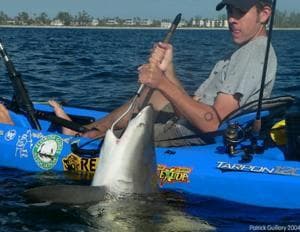
Sharks can and will bite you. That needs to be on your mind from the moment you set the hook until you cut it free. Sharks sometimes feed in schools, and attracting one with a chum slick can attract many, which may not be a great idea for someone in a plastic boat. They can bite their own tail, so handling is doubly dangerous. Be prepared to cut the line, because you really don't want to try and save that hook. They give a heavy tug with the ever present probability that they'll cut through your line. So even though you're applying constant pressure on the fish, be prepared in case that resistance disappears suddenly. This could lead to a premature departure from the vessel, and you may find yourself in shark infested waters. Sharks can and will bite you.
Marlin:
They jump high, swim fast, and fight hard. They also prefer some pretty deep water. They won't bite you like a shark will, but that bill needs to be given plenty of respect. Since these fish prefer deep offshore waters, paddle anglers normally pursue them with the help of a boat. The fight is still memorable for sure. But for me, I'd sure feel safer knowing a nice comfy boat was close at hand.
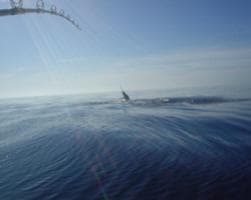 | 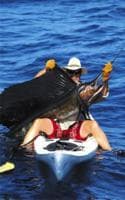 |
Tarpon:
I've never caught one from a kayak, but based on the info I've gathered, in my opinion large tarpon are the most dangerous of the extreme fish to encounter, for a number of reasons:
- They have a very tough jaw, so the hook set needs to be done with authority. Imagine how it'd feel to attempt a hook set on a 200 lb fish only to find that there's nothing on the other end. This could lead to a premature departure from the vessel.
- Once hooked, tarpon love to jump. During the fight, you'll encounter periods of tight line, followed by periods of slack line (bowing to "the king" during jumps). Failure to react appropriately to these changing situations could result in a premature departure from the vessel.
- Tarpon can be targeted from beaches, which tempts many paddle anglers to try it paddling solo. However, the fight can take you miles offshore. Good judgment is crucial here. Better to break off the fish than to count on the Coast Guard to come to your aid.
- As the tarpon is jumping and thrashing around, it will often get the attention of large sharks. Sharks are opportunistic feeders and a tired tarpon makes a pretty easy meal. Chances are good that if one shark noticed the commotion, so did others.
- Sharks aren't easily scared when food is concerned, so it's not uncommon for a big shark to take a swipe at a tarpon while it's being held for the photo.
- Due to the shark factor, it's imperative that you stay in the boat. It's also imperative that in the event of a premature departure from the vessel, that you know how to quickly and effectively make a deep water re-entry into your kayak. Legs franticly kicking in the water could resemble something else (like a tarpon thrashing), and that could lead to a progression of nasty, nasty events.
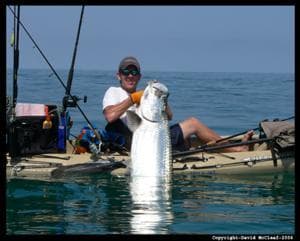
Using The Kayak As A Tool:
This may not be "extreme", but it's certainly innovative. Many anglers use their paddle craft simply to access areas from which to wade or fish from the shore. But some use their boats to carry big baits off the beach in search of big game. This tactic can be very rewarding - you just never know what might be out there just past the breakers.
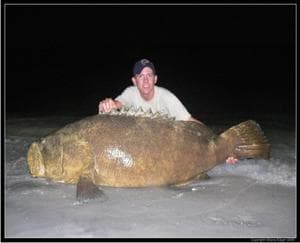
When Things Don't Go As Planned:
Hope for the best, but plan for the worst, as best you can. If you're lucky, the worst that will happen is that you'll hook in to that monster fish and it will break off. From there, the variables are virtually endless. Remember, the secret of success is not how well you do, but how well you recover. Know when to concede defeat, or at least call it a day. In some battles, you simply don't win. Remember, even with our intellect and technology, the fish always has the "home field advantage" - always.
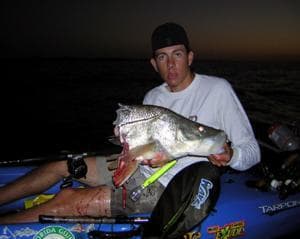
The $64,000 Question:
WHY DO THIS? Most fish sought by extreme paddle anglers aren't table fare, so why bother? They do this truly for the sport. Many do it for the thrill, the challenge, the glory, and of course, the picture. In these digital days, if there's no picture, it didn't happen. So, make sure that you're properly prepared to make a high resolution pixilated memory of your catch. Better yet, make sure you have a buddy along that's ready to help, sort of like a designated driver. Only in this case, it's perfectly acceptable to post the resulting pictures on the Internet.
Words About Safety:
By making this the last thing you read I'm hoping it will be the first thing you remember after you finish reading this article. Whether you're a racing fan, a football/hockey fan, or just someone that drives a car, you know that most safety gear never gets used. But, when used properly, it can save your life. Safety awareness and proper gear is important with any paddle sport, but for these types of extreme angling, safety should be a major concern. I'll briefly touch on just a few safety items, but I hope that before you attempt to sample this side of the sport, you'll make a longer, more comprehensive list.
- PFD: It doesn't work unless you wear it. There are a lot of comfortable options out there today, so excuses for not wearing one fall on deaf ears. But, should you choose not to wear one, at least make sure it's close enough to grab should you need it, and not stuffed into a closed hatch.
- Float plan: File one with someone that has proper phone numbers of authorities in your area.
- Buddy system / powerboat aid: This may be one of the best safety items you can have. Best case scenario - they'll be there to take pictures, help you revive the fish, and share a few smiles on the way back to the launch. Worst case scenario - they'll be there in case you need them. Win/Win.
- Submersible VHF radio / GPS: You or your buddy should have both, and know how to use them. Should you need help, a good form of communication and knowing exactly where help should be sent could save your life. Make sure both items are fully charged before you leave, and also make sure they're secured to you or the boat by some means.
- Paddle leash: Make sure the paddle is secured to the boat. In the heat of the battle you may not have a free hand to secure your paddle.
- Knife: In case you need to cut your losses or release your fish, you'll need a good sharp knife handy.
- Drift chute: If you need to slow that big boy down a drift chute is a very effective tool. It can be deployed with one hand and will help you hold your position while putting a bit more pressure on the fish.
- Know How To Effectively Perform A Deep Water Self-Rescue: Once again I saved the most important for last. Many paddle anglers are better at fishing that kayaking, and as a result, their basic kayak skills are lacking. A deep water self-rescue is hard enough on calm water. But add some chop, add a lot of gear, and just to make it interesting, throw a shark or two and a healthy dose of adrenaline into the mix, and the degree of difficulty goes off the scale. So, please take the time to learn how to do this properly. And, always understand that lost gear can be replaced (upgraded), provided you're still around to do it.
With proper planning, this segment of the sport can be relatively safe, and most assuredly exciting. I never really thought that much about doing this sort of paddle fishing, since I'm definitely a flat-water guy. But after browsing dozens of pictures and doing the required research, I gotta go. Shane, you've got mail!
See you out on the water …
Many thanks to Shane Edgar (www.hightailincharters.com), and to Jim Sammons (www.kayak4fish.com) for their input on this article. Thanks also go to Patrick Guillory and David McCleaf for not only providing great pictures that I used in this article, but also for being there in case their buddy got in trouble.
"Many men go fishing all of their lives without knowing that it is not fish they are after" ~ Henry David Thoreau
Related Articles
Since the last fishing video, which was my first kayak fishing video, I've been out on super early…
Watch this kayak angler demonstrate true kayak fishing finesse by saving his most prized possession, his…
When you can't find a kayak that fits all of your needs as a fisherman, build one! Check out this custom…
Watch as a kayak angler catches a massive catfish while at anchor.--Transcription"On this trip, I hooked…



